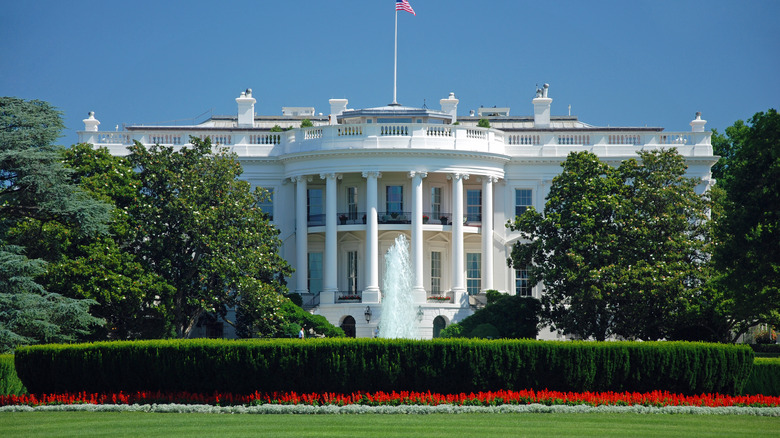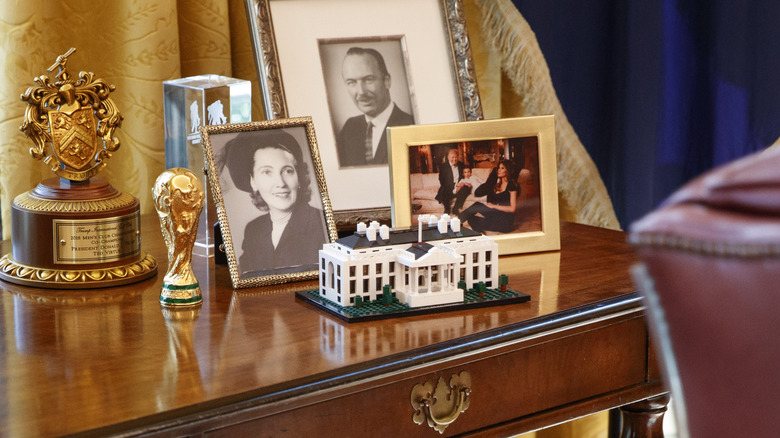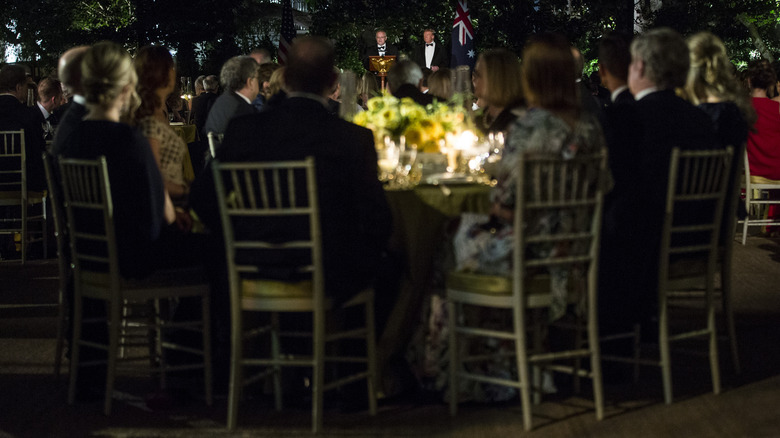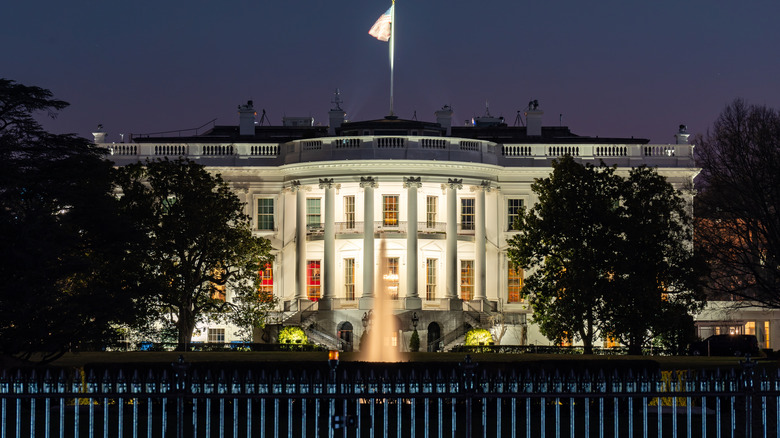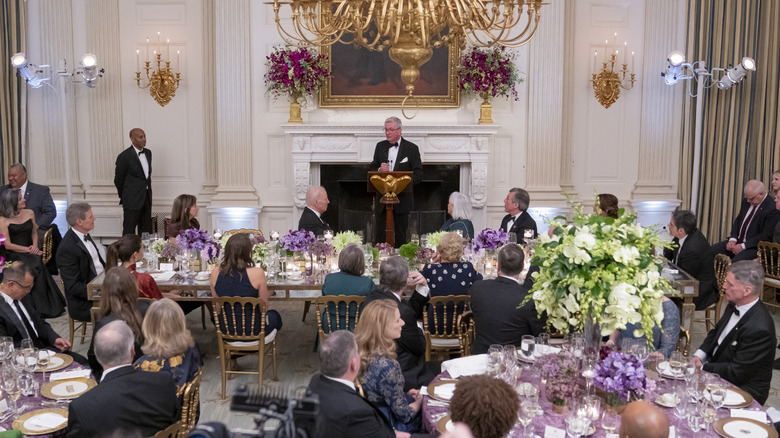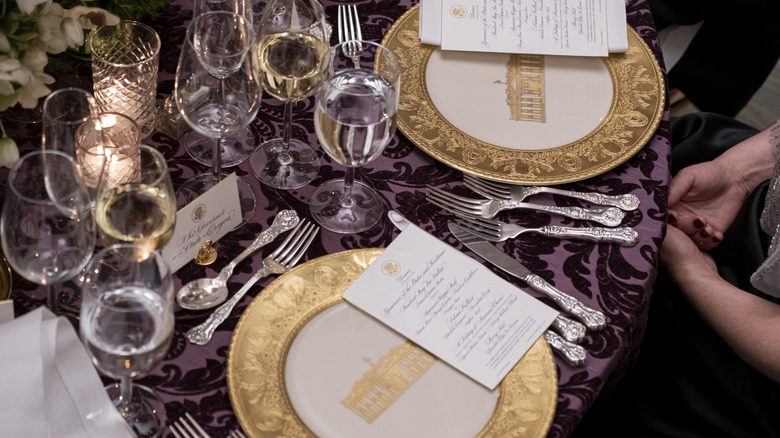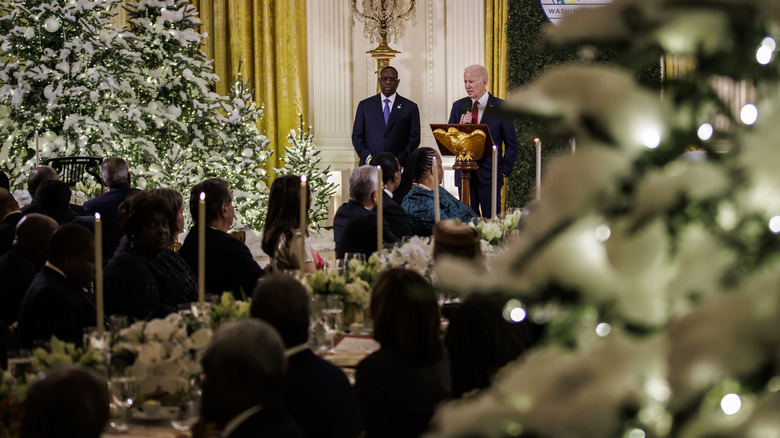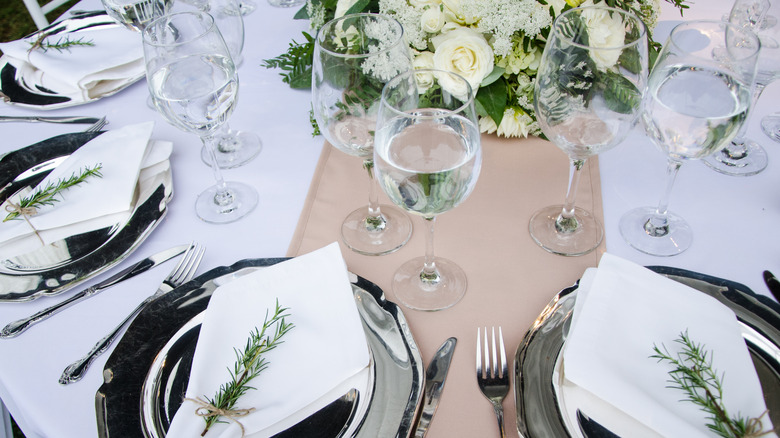What Are White House Social Secretaries And What Do They Do?
Anyone who's ever planned a wedding understands that large-scale event planning is not a career choice for just anyone. Besides having to keep track of what feels like a million guests and vendors at the same time, you have to plan for every contingency, soothe and reassure anxious hosts, and be scrupulously polite to people who are driving you insane.
Now if that weren't hard enough, imagine being the full-time social coordinator and event planner for one of the most visible households in the world. On top of your already demanding regular event planning duties, you have to worry about the security of your guests, cross-cultural etiquette, and the sizeable egos of your A-list guests. Oh, and on top of that, your every choice will be scrutinized by the media.
This is pretty much the job description of the White House social secretary. This usually unsung, but critically important, person is largely responsible for setting the tone of White House event and thus for establishing the public image of the current president and First Lady themselves. Washington reporter Roxanne Roberts describes the role to Town and Country saying, "They are the ghostwriters of the entertaining world. Their job is to assist the First Lady or Second Gentleman—whoever is in charge — on entertaining at the highest level."
Here's what it's really like to take on this glamorous, yet grueling, role.
Many White House social secretaries fell into the job by chance
The role of the White House social secretary is a relatively recent one. The role didn't exist until Edith Roosevelt, wife of then-president Theodore Roosevelt, hired Isabella Hagner as her full-time social secretary. Since then, subsequent social secretaries have also been selected by the First Lady and answer directly to her. Beyond this convention, however, the secretaries' roads to the White House have been as varied as the First Ladies themselves. While Jacqueline Kennedy chose a longtime friend for the role, Betty Ford sought recommendations from White House staffers before appointing Maria Downs to the position.
But while the job of White House social secretary seems like a gig ambitious people would spend years angling for, many holders of the position said it simply fell into their laps. "[Being social secretary] isn't a job you necessarily apply for," Amy Zantzinger, who worked with Laura Bush, told The White House Historical Association. "It's much more a job that you ease your way into...you're in the right place at the right time."
And according to the historical association, the first-ever White House social secretary, Isabella Hagner, who served in Roosevelt's administration, believed this was exactly the way it should be. "I would like to say that ever since this position was created for me, I have always felt very strongly that the job of secretary to the President's wife is one which should not be solicited. I am happy to say that both times in my case, I was asked to take the place, without ever raising a finger to get it," she said.
The White House social secretary must be good at soothing egos – and saying no politely
As the lead organizer of state dinners and high-profile events honoring prominent guests, White House social secretaries come into contact with a lot of famous people. And as we all know, people who are used to being worshipped and always getting their way aren't always the easiest to please or get along with. Thus, a critical part of the social secretary's job is ensuring prickly guests feel seen and respected without letting them walk all over everyone else. "It's also a little volatile because people are exuberant, but the social secretaries are there to smooth and soothe," Lea Berman, social secretary for Laura Bush, told NPR.
Another important (and difficult) skill social secretaries must master is the ability to say no, firmly but politely. For instance, a high-profile celebrity once complained at a White House dinner about being seated between two unfamiliar (and non-famous) people. The social secretary gently informed the celebrity that the two were the children of the evening's guest of honor, and suggested the celebrity leave if they felt uncomfortable. Of course, they stayed. A more common problem is facing the wrath of A-listers who thought they'd be invited but weren't. "We are the blame takers. Because there are always more people who want to come to the White House than there is space for them," Lea Berman, social secretary for Laura Bush, told Town and Country.
White House social secretaries must be super-organized and collaborative
Obviously, organizing a state dinner at the White House will involve much more than sending out an Evite and picking up some food. In reality, the planning process is a complex diplomatic operation requiring input from multiple agencies and offices. These include the White House Chief Usher and his or her office, the State Department, the Secret Service, the Office of the Chief of Protocol, the Office of the White House Press Secretary, and the White House Military Office. And the White House social secretary is the point person for all these operations.
This means the White House social secretary is not only responsible for traditional event-planning tasks such as planning menus and decorations. They must keep track of all the requirements identified by these agencies along with ensuring the event goes smoothly. Adding to the challenge is the state dinner or special occasion is probably just one of many White House events being planned at the time. When asked how he manages to juggle the flurry of post-pandemic White House social activity, current White House social secretary Carlos Elizondo had a simple answer. "Lots of caffeine," he told U.S. News and World Report.
Assembling guest lists for state dinners is a complicated – and fraught – responsibility
Putting together guest lists for big events such as weddings can be a sensitive matter. Acquaintances might feel snubbed if left off your list, and there's always that one relative who loudly declares he or she won't go if that certain other relative shows up. And for White House state dinners, the stakes are even higher. Invitations are highly sought-after by social climbers, and White House social secretaries know that some will be upset not to be invited. Conversely, those already high on the social ladder know they can send a very loud message by snubbing the invitation.
Thus, the planning of guest lists for state events — a key responsibility of the White House social secretary — is more like a military operation than a social responsibility. Upon being notified that a state dinner is being planned, the social secretary contacts the White House staff for their recommendations and reviews the list of invitees from the visiting delegation provided by the State Department. The social secretary also solicits suggestions from the president and First Lady. Finally, the social secretary makes recommendations for additional guests, such as cultural and literary figures, who can add interest and flair to the event.
Technology has made the job both easier and harder
When the role of the White House social secretary first emerged near the turn of the twentieth century, the role involved mostly hands-on work. Like regular office secretaries, they typically handled tasks such as answering phone calls directed to the First Lady and responding to letters sent to the White House. The social secretary was also personally responsible for sending out invitations to White House events.
With the rise of technology — and the professionalization of the position — many of these tasks can now be automated or delegated to other staffers. But technology has also added new demands to the social secretary's job. With the rise of social media and the 24-hour news cycle, the level of scrutiny targeting the White House and everything that happens there is far higher, and the room for error is much lower. Low-level gaffes or perceived snubs that would have been quickly forgotten in earlier times can now be immediately tweeted for the whole world to see. Thus, while the social secretary's role always required a deep understanding of Washington's political and social scene, it now also requires a sharp awareness of any online discussions that could reflect badly on the White House.
Only two males have ever held the position
The first-ever White House social secretary, Isabella Hagner, was originally hired by then-first lady Edith Roosevelt as a personal assistant, and she soon become a confidante of the family and something like an aunt to the Roosevelts' children. Up to that time, the White House had always engaged a male clerk to manage event planning. But after Hagner was hired, she and the official then in charge of White House social events, Colonel Theodore Bingham, began to butt heads. The conflict culminated when Hagner eventually pushed him out of his job.Since then, the social secretary's role has always been connected with the First Lady's office, and until recent times, White House social secretaries were always women.
This has started to change, however. In 2011, Jeremy Bernard became the first male, and the first openly gay person, to hold the position of White House social secretary, working under Michelle Obama. He brought plenty of experience to the position. He'd previously been a senior advisor to the United States ambassador to France and before that, White House liaison to the National Endowment for the Humanities. Bernard opened the door for another man, Carlos Elizondo, to take the position, answering to Jill Biden. Like Bernard, he's also a ground-breaker in another way, being the first Hispanic American to hold the position.
Staying under the radar is point of pride for White House social secretaries
The position of the White House social secretary is a bit paradoxical. On one hand, it requires a person with a flair for glamour who's unafraid of the spotlight, along with the confidence and social skills to engage comfortably with celebrities and world leaders. But on the other hand, it also requires profound humility. White House social secretaries understand that the big, glitzy events they plan and execute are not about them. Ultimately, their job is all about making their bosses look good. "The best social secretaries are the ones you never hear about," Lea Berman, White House social secretary to Laura Bush, told Town and Country.
Others who've held the post share the sentiment. "My main advice [to my successor] was to keep it low-key. It's not about you, and you never want to do anything that will embarrass the president or first lady," Jeremy Bernard, White House secretary to Michelle Obama, told NPR. Bernard should know: His predecessor, Desiree Rogers, was determined to pave her own way and somewhat reinvent the role. She chose to break with the tradition of discretion and once made herself a guest at a state dinner she was organizing. The fact that a high-profile couple crashed that very event without an invitation caused a minor scandal, and she left the position soon after.
Former White House social secretaries share a special bond
The position of White House social secretary is truly unique, with a set of demands and job stressors that few people can understand or personally relate to. It's true that the general responsibilities of the job are fairly well defined. However, there's no government manual outlining exactly how to choose the right floral arrangements, select the right mix of invitees, or navigate sticky social situations involving high-profile (or drunk) guests. Thus, over the years, White House social secretaries have come to rely on their predecessors for advice and support, as well as fellowship.
And the shared experience and mutual respect connecting the former White House social secretaries transcend any political differences between the administrations they served. As a striking example, the transition between the Trump and Biden administrations was anything but smooth or gracious. But Melania Trump's social secretary, Rickie Niceta, has nothing but genuinely nice things to say about her successor, Carlos Elizondo. "Carlos is divine. He knows exactly what he's doing, he has wonderful taste, is a lovely person, is gracious, and is real. He knows the President and First Lady so well that he can make everything seamless for them," she told Town and Country.
Deciding who sits where can have serious implications for global diplomacy
Much of the White House social secretary's work may seem trivial compared to the other serious issues the White House faces from day to day. After all, when there are international conflicts to mediate and critical domestic challenges to deal with, who cares who gets invited to a White House dinner? And does it really matter who gets to sit next to whom?
But the invitees do care. White House social secretaries know their decisions in these areas, unimportant as they may seem, can have global repercussions, especially when high-profile world leaders are involved. Thus, designing optimal seating charts requires political savvy as well as a fair amount of research on the people involved. "If an ambassador doesn't get properly seated it can cause international friction, or a big donor who won't want to give any more money if they don't get a seat they like," longtime Washington hostess and event planner Sally Quinn explained to Town and Country.
White House social secretaries must pay attention to tiny details
A job demand that likely gives White House social secretaries whiplash is having to constantly pivot between the big-picture demands of their job, like the guest list and location, and the little ones, such as menu choices and color themes. A lot of the social secretary's job is organizational and administrative — such as collaborating with other White House offices to determine their needs and involvement in planned events. But there's also a lot more detailed, hands-on work than one would imagine for such a high-profile position.
In an interview with CNBC, former White House social secretaries Lea Berman and Jeremy Bernard agreed that paying attention to small details, such as carefully proofreading letters and writing thank-you notes after each event, have been important contributors to their success. And one of the best-known White House social secretaries, Leticia Baldridge, was known for her willingness to take on any task needed to make the White House an agreeable place to be. When President John F. Kennedy complained of an unpleasant smell during a renovation project at the White House, Baldridge decided to walk around and try to solve the problem herself. It didn't take long for her to zero in on the cause — a worker who regularly brought Limburger cheese sandwiches for lunch.
By tradition, White House social secretaries meet and train their successors
People who've shared a challenging experience often develop tight social bonds because of this — think of military buddies who still meet regularly years after their service or fraternity members who've undergone the same challenging initiation rituals. Former White House social secretaries also form a similar (mostly female) fraternity. Besides bonding over their the highs and lows of their unusual job, they also consider it their responsibility to support and advise the current holder of the position.
Because of this, a charming tradition has evolved: The incoming social secretary hosts a luncheon for all of his or her surviving predecessors. This allows them to hear their advice and suggestions, as well as to ask them any questions about the position and its duties. Ideally, however, this wouldn't be the first time the incoming social secretary got to meet at least some of them. By convention, those being considered for the job are expected to reach out to former White House social secretaries for guidance on what may lie ahead for them.
